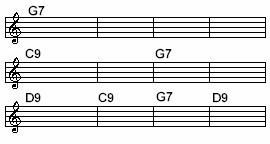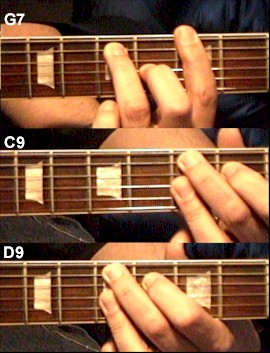Scroll through the lesson and click on notation/video/audio links to load the interactive players.
Please subscribe to get full access to all lessons for only $7.95/month PLUS 1 week free trial.

Riff Interactive lessons are
LESS expensive and
MORE interactive than alternatives!
More Info
|
|

Jam Sessions - All
Blues Styles
Lesson 9 - Blues Shuffle In G Lesson Sample
Lyle:
Good to see you all here tonight. This lesson will focus on how to play a blues
style that might remind you of Stevie Ray Vaughan. Here's your jam
track:
jam track -
Blues Shuffle in G
chord
chart

Lyle: You're going to learn how to jam along to
this jam track. For the first rhythm riff I suggest you use a basic clean
setting if you're using an electric guitar. You could use a just a little
overdrive, hardly noticeable if you know what I mean. Try using a single coil
pick-up with little or no effects.
Lyle: As you can see in the chord chart above,
this is another basic 12 bar blues progression in G so your three chords will be
G, C, and D. Instead of using those 3 basic major chords you'll use dominant
chords, which will give you a bluesy sound than if you were to use just plain
major chords.
chords
chords

Lyle: Remember that dominant chords are built
from major triads, 1 - 3 - 5 degrees of the major scale and then a b7 added to
the triad. The "9" chord is (1 - 3 - 5) - b7 - 9.
G7 =
1 - 3 - 5 - b7
G - B - D - F
G9 =
1 - 3 - 5 - b7 - 9
G - B - D - F - A
Lyle: This rhythm riff uses all up strokes,
on the "up beat".
rhythm riff 1 in G
rhythm riff 1 in
G
Lyle:
This rhythm riff uses a type of chord muting that helps give you that tight
rhythm accent for each up beat in the measure. Right after you hit the chord
your left hand releases pressure just slightly of the strings to stop the chord
from ringing, at the same time your right hand dampens the strings down by the
bridge to aid in muting. (see video) It will take some practice if this is new
to you. Here's a close-up video clip that shows how both hands help with muting
each strum right after you hit it.
muted upstroke
Lyle: I
can hear you jammin from here!
Lyle: Learn the rhythm riff and play along to the
Jam Track.
Lyle: Let's move to another rhythm riff you can
play over this progression. Here's the main riff to learn first. Use a slight
palm mute effect by touching the heal of your right hand on the bass strings
back on top of the bridge saddles. Notice that the strings should sound a little
muffled.
rhythm
riff 2 example
Lyle:
After you learn this riff you can play it for any chord up and down the neck.
Your root note will be on the 6th string. Examine and then learn this rhythm
riff in action:
rhythm riff 2 in G
rhythm riff 2 in
G
Lyle: I
choose to stay on the 6th string bass note for the C and D chords to remain
consistent with the over-all tone of each chord. Fatter strings make for fatter
tone, so by keeping the C and D chord based off the 6th string, you'll get the
fattest sound tone from each chord compared to playing it anywhere else. It is a
little tricky moving your wrist that fast to get from G to the C or D chord and
it's ok of you hear a little bit of slide between chords.
Lyle: Now look at the way you can change every
fourth note of the groove:
alternate rhythm riff 2 example
Lyle:
You can use this new alternate version for the C and D chord. This groove seems
to give a little extra swing to the sound. Sometimes you want that, sometimes
you don't. Try mixing the two patterns together.
Lyle: Now you're going to learn a solo that uses
notes from two slightly different
scales:
G maj
pentatonic
G min
pentatonic
Lyle:
Since the blues progression is based around major type chords, I like to use the
major pentatonic scale, then switch to the minor pentatonic during the IV chord
(C), then back to the major pentatonic. Analyze this solo and you'll see and
hear where it switches between the two scales:
Blues
Shuffle in G solo
Blues Shuffle in
G solo
ToneDeafVagrant: Nice, It's the same scale pattern, just
shifted up the neck for the min
pentatonic?
Lyle: That is right!
Lyle: Next lesson you'll do this jam in the key
of E.
ToneDeafVagrant: Min pentatonic over the one sounds sort
of muddy due to the b3? - major sounds much better over the 1.
Lyle:
Look at this TAB, you'll see the G7 chord and the G major pentatonic share the B
natural note, which is not in the minor pentatonic.
Gmaj
pentatonic
Lyle:
Here's the C9 and the G min pentatonic. You'll see they share the same note, but
a half step lower than the G7 and G major pent:
G min
pent
Lyle:
Let's take a break here. In the next lesson you'll be able to take what
you've learned here and transpose it to the a Blues Shuffle in
E.
|
<< load notation from left
|
|
<< load audio from left
|
<< load audio from left
|